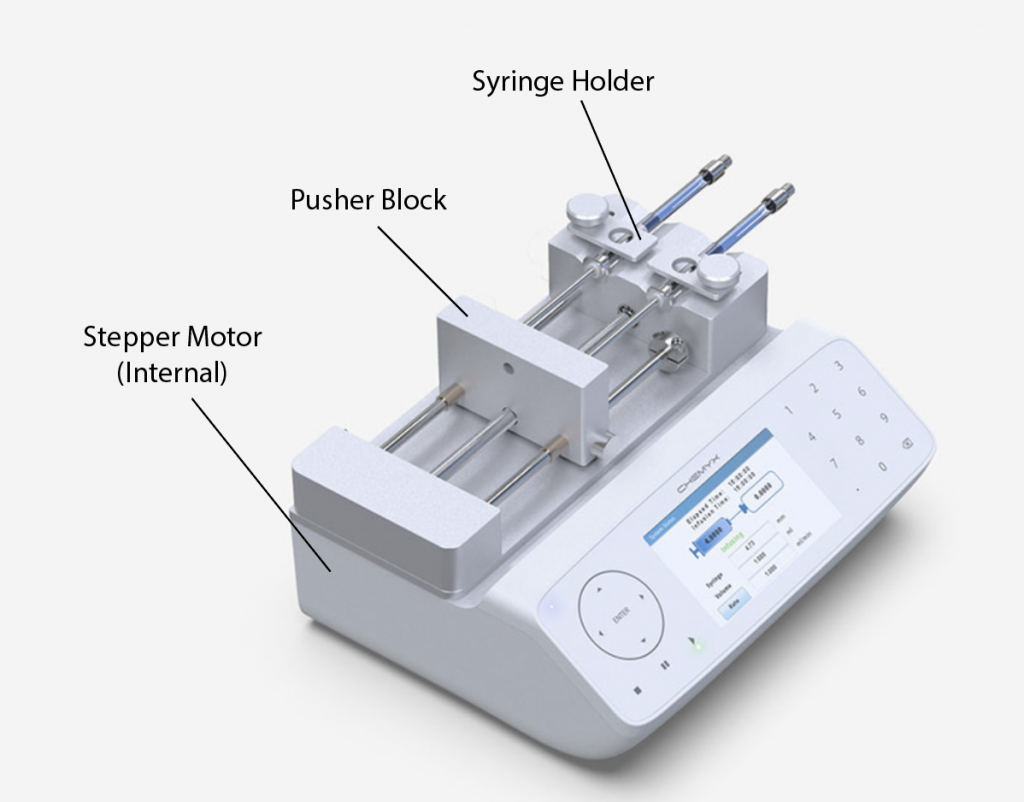A syringe pump is a motor-driven precision pump that uses one or more syringes to deliver precise and accurate amounts of fluid in high-impact research environments. Precision and high pressure syringe pumps are fundamental instruments in modern research and industrial laboratories. They have the ability to deliver precise, pulseless, and reproducible fluid volumes is for applications ranging from microfluidics and analytical chemistry to pharmaceutical development and novel material discovery.
Types of Syringe Pumps
There are two broad types of syringe pumps, laboratory pumps, and Medical infusion pumps.
- Laboratory Syringe Pump: These are devices used in research laboratories for applications that require very accurate fluid deliveries. Lab research syringe pumps function by handling smaller volumes and offering additional features that medical pumps do not have. Such as the infuse and withdraw pump and multi-syringes syringe pump. OEM module syringe pump and high-pressure syringe pump. The OEM module syringe pump and high-pressure syringe pump have been found useful in industrial applications recently.
-
Medical Infusion Pump: These are devices used to deliver controlled quantities of fluids such as nutrients, drugs, and blood to patients. This type of infusion pump can be used for in vivo diagnosis, treatment, and research.
Medical Infusion Pump vs. Laboratory Syringe Pump
|
Features |
Medical Infusion Pump |
Research Syringe Pump |
|---|---|---|
| Targeted use | In vivo | Basic science |
| Hazards | Frequently subject to U.S. FDA recalls | No special hazards |
| Accuracy/precision of flow | Less need for high accuracy/precision, not necessarily pulseless flow | At least nanoliter accuracy/precision readily achieved, option for pulseless flow |
| Pressure or temperature control | Occlusion only | Available |
Lab Syringe Pump Design and Features
While the syringe pump design differs according to the application, all lab ones consist of the following:
Syringe Pump Parts

Chemyx Fusion 100-X Infusion Pump
The motor drives the plate, pushing the plunger which ejects the fluid from the syringe. Continuous flow can be achieved by using pumps with two syringes, where one pulls liquid and the other pushes liquid.
Most modern syringe pumps can be programmed for higher accuracy and improved control, and some models can be connected to a computer to record the infusion history. Moreover, syringe pump systems that have adjustable syringe holders are more versatile in their applications.
In addition, some syringe pumps can have both infusion and withdrawal features, and others can accommodate multiple syringes (up to 11 syringes). They can operate at very small volumetric flow rates (in the micro, nano, and pico ranges) while offering pulseless flow with very high precision in delivery.
Many parameters can be controlled in modern syringe pump applications. For example, pressure control facilitates handling liquids with high viscosity or to introducing fluids under high pressure. Syringe heaters offer temperature control for the syringe. Some syringe pumps allow users to switch between different syringes to regulate the working range.
Syringe Pump Uses and Functions
- At the research lab, syringe pumps can be used in almost any application that involves precise metering, especially at the micro and nanoscale.
- They are used in many research fields as precise dosing systems, or to accurately deliver small quantities of reagents, mix minuscule volumes, and add traces of specific chemicals over the course of the experiment.
- Syringe pumps compatible with microfluidic applications are available in the market, which facilitates research in fields such as micro-environmental control.
- Microfluidic applications of syringe pumps have increased dramatically in the vaccine research area.
- Syringe pumps can also facilitate precise infusion in medical and biological research; for instance, feeding small animals or delivering very small doses to specific sites in the brain in neuroscience research.
In industrial applications
- Syringe pumps can be used for scale-up, new material development, and materials characterization in chemical, pharmaceutical, catalysis, and materials science research. They can also play a major role in minimizing errors in the fields of microanalysis and instrumental analytics, such as mass spectrometry (MS), high-performance liquid chromatography (HPLC), and liquid chromatography-mass spectrometry (LC-MS).
In conclusion, syringe pumps are useful for accelerating research and minimizing fluid delivery errors in many advanced research fields.
Infusion Pump History
Researchers originally developed infusion pumps, of which syringe pumps are one type, for controlled drug delivery. Christopher Wren invented the first infusion pump in 1658, but technical limitations, botched blood transfusions, and government bans slowed development. New prototypes appeared in the 19th century, and an infusion pump was first used for chemotherapy in the 1950s (to administer Fluorouracil, 5FU).
Smaller, more cost-effective ambulatory pumps (i.e., portable and wearable) appeared in the 1970s and 1980s, facilitating the practical use of infusion pumps not only for outpatients but also in animal-based and other research. In particular, Dean Kamen—elected to the National Academy of Engineering in 1997 and perhaps best known for bringing the Segway to market in 2001—invented an ambulatory infusion pump for insulin administration to diabetic patients.
Computerized pump advancements, efficiency enhancements, and pump miniaturization in the 1980s and 1990s increased infusion devices’ use in research. In particular, combining ambulatory technology with PC communications helped researchers identify and troubleshoot problematic pump performance.
The development of “smart pumps” in the early 2000s brought increased versatility to research and safety to patients. Advantages include increased accuracy and precision, digital storage of and access to dosage guidelines, remote programming, and so on.

